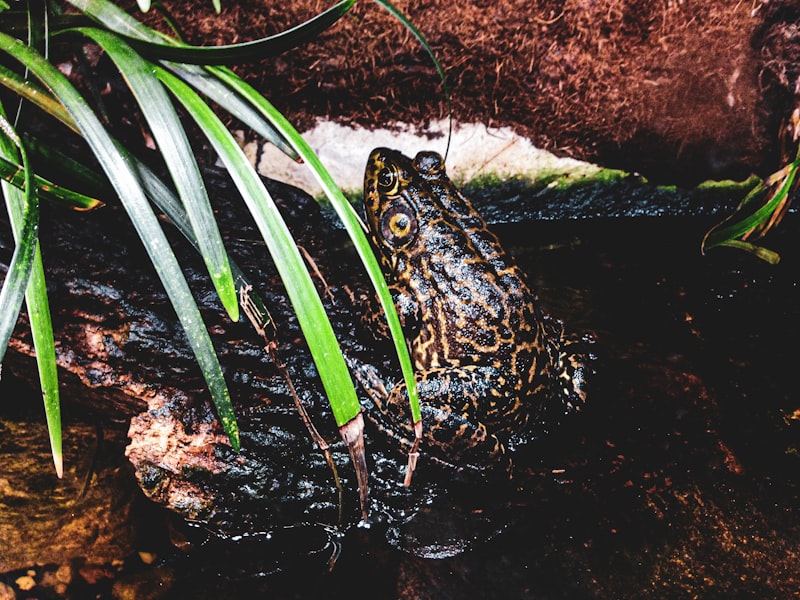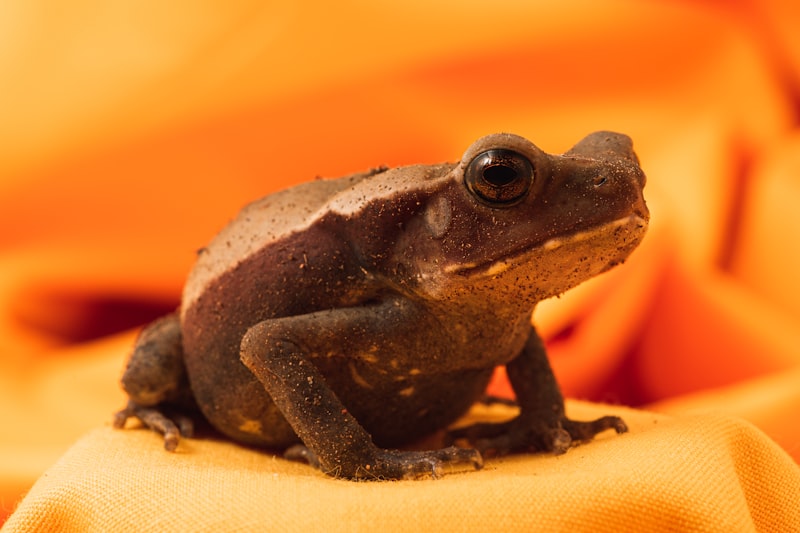
Amphibians, like frogs, toads, newts, and salamanders, are renowned for their dual life stages, transitioning from water-breathing larvae to air-breathing adults. This unique trait makes their care requirements quite distinctive compared to other pets. So, how do you ensure these slimy companions thrive under your care?
Firstly, habitat setup is key. Think of it as creating a mini ecosystem tailored to your amphibian’s needs. Depending on the species, you may need an aquarium with both water and land areas, or just a moist terrarium with ample hiding spots. Substrates like moss or coconut fiber mimic natural environments and help maintain humidity levels critical for amphibian health.
Temperature and humidity control are crucial. Most amphibians prefer a cool, moist environment, so investing in a reliable thermometer and hygrometer is a must. Regular misting keeps the habitat humid, mimicking the misty mornings these creatures love.
Feeding your amphibian friends requires a bit of variety. From live insects like crickets and mealworms to earthworms and even specialized amphibian pellets, there’s a menu to suit every palate. Some species even enjoy the occasional fruit treat, like small bits of banana or melon.
Now, let’s talk about companionship. While amphibians aren’t exactly social butterflies, some species can live in groups if provided adequate space. Always research the specific social needs of your pet to prevent any finny disagreements.
Lastly, regular maintenance ensures a healthy environment. Cleaning tanks, checking water quality, and monitoring your pet’s behavior are all part of the responsibility package. Remember, amphibians rely on you to recreate their natural habitat and keep them safe and happy.
So, whether you’re enchanted by the graceful movements of frogs or the mysterious stillness of salamanders, keeping pet amphibians is a journey into a world where land and water intertwine, and the ultimate goal is to create a thriving microcosm in your home.
Dive into Amphibian Care: Essential Tips for Pet Owners
One of the fundamental aspects of amphibian care is creating the right habitat. Unlike typical pets, amphibians require environments that mimic their natural habitats. This means ensuring proper humidity levels, temperature gradients, and substrate choices that cater to their specific needs. For instance, frogs may need a moist substrate to maintain skin health, while newts might require a mix of water and land areas in their tank.
Feeding amphibians also demands attention to detail. Their diets vary widely based on species, ranging from insects and worms to specialized amphibian pellets. It’s essential to research the dietary requirements of your specific pet to ensure they receive adequate nutrition. Providing a varied diet enriched with vitamins and minerals is key to maintaining their health and vitality.
Amphibians are sensitive to water quality, making regular tank maintenance crucial. Proper filtration and regular water changes help prevent the buildup of toxins that can harm these delicate creatures. Monitoring water pH levels and ensuring it’s chlorine-free are essential steps in maintaining a healthy aquatic environment for amphibians.
Handling amphibians requires a gentle touch due to their delicate skin and susceptibility to stress. Limit handling to necessary tasks like feeding or tank maintenance to minimize stress. Always wash your hands thoroughly before and after handling them to avoid transferring contaminants.
Understanding the unique needs of amphibians and providing attentive care ensures they thrive in captivity. By creating a suitable habitat, offering a nutritious diet, maintaining water quality, and handling them with care, pet owners can enjoy the companionship of these fascinating creatures for years to come.
Mastering the Habitat: Creating the Perfect Home for Your Amphibian
Imagine your amphibian’s habitat as a miniature rainforest—a place where they can feel at home and explore without stress. Start with the basics: a spacious terrarium with ample space to roam and hide. Incorporate natural elements like live plants and moss to maintain humidity levels and provide hiding spots. These plants not only beautify the habitat but also contribute to air quality, creating a healthier environment for your pet.
Temperature regulation is crucial. Most amphibians prefer temperatures that range from mild to warm, depending on their species. Use a reliable thermometer to monitor the temperature gradient within the terrarium, ensuring there are cooler and warmer zones for your pet to regulate its body temperature comfortably.
Consider the substrate—the material that lines the bottom of the terrarium. Choose substrates that mimic the forest floor, such as coconut fiber or organic soil, which retain moisture and support plant growth. This substrate not only aids in maintaining humidity but also allows your amphibian to burrow and exhibit natural behaviors.
Water quality is paramount for amphibians, many of which require access to clean, dechlorinated water for drinking and soaking. Provide a shallow water dish or a small pond area with a gentle slope for easy access. Change the water regularly to prevent bacterial growth and maintain freshness.
Lastly, lighting plays a vital role in your amphibian’s habitat. Some species require UVB lighting to metabolize calcium and maintain healthy bones. Research your amphibian’s specific lighting needs and provide a suitable setup that includes both UVB and a natural day-night cycle.
From Tadpole to Terrarium: Nurturing Amphibian Growth
Have you ever wondered about the fascinating journey of tadpoles transforming into frogs within a terrarium? It’s truly a marvel of nature’s transformational processes. Amphibians, like frogs and newts, start their lives as tadpoles in water bodies like ponds or streams. These tiny creatures undergo a remarkable metamorphosis, growing limbs and developing lungs as they transition from aquatic life to terrestrial beings.
Nurturing amphibian growth from tadpoles requires careful consideration of their habitat and diet. A terrarium provides a controlled environment that mimics their natural habitat, ensuring optimal conditions for their development. The enclosure should have both land and water areas, allowing them to transition as they grow. It’s like creating a miniature ecosystem where these amphibians thrive and evolve.
One key aspect of nurturing tadpoles is their diet. Initially, they feed on plant matter and algae found in their aquatic environment. As they mature into frogs, their diet shifts to include small insects like crickets and flies. Providing a varied diet rich in protein and nutrients is essential for their healthy growth.
Amphibians are sensitive to environmental changes, so maintaining proper humidity and temperature levels in the terrarium is crucial. It’s akin to creating a comfortable home where they feel safe to grow and explore their surroundings. Monitoring these factors ensures their well-being and supports their developmental stages effectively.
Nurturing amphibian growth from tadpoles to frogs in a terrarium is a rewarding experience that allows us to witness the wonders of nature up close. By providing a suitable habitat and nutritious diet, we facilitate their journey from aquatic larvae to fascinating terrestrial creatures.
Choosing the Right Species: Finding Your Ideal Amphibian Companion
Are you considering bringing an amphibian into your home, but unsure which species would make the perfect companion? Amphibians, with their unique characteristics and captivating behaviors, can indeed make delightful pets. However, selecting the right species is crucial for both your enjoyment and the amphibian’s well-being.
One of the most popular choices among amphibian enthusiasts is the charming Red-Eyed Tree Frog. Known for its vibrant green body and striking red eyes, this species is not only visually appealing but also relatively easy to care for. Their arboreal nature means they require a tall terrarium with plenty of branches for climbing and foliage for hiding.
For those seeking a more interactive pet, the African Dwarf Frog is an excellent option. These tiny aquatic frogs are active swimmers and often display amusing behaviors like chasing after food or playing in the water currents. A small, well-filtered aquarium with gentle water flow and live plants mimics their natural habitat and keeps them healthy and happy.
If you prefer something a bit more exotic, the Axolotl is sure to fascinate. Often referred to as the “Mexican Walking Fish,” although it is actually a type of salamander, the Axolotl is entirely aquatic with unique external gills and a permanently larval appearance. They require a spacious tank with cool water and places to hide, making them a mesmerizing addition to any aquatic enthusiast’s collection.
For those seeking a unique challenge, the Poison Dart Frog offers striking colors and intricate behaviors. Despite their small size, these frogs are known for their toxic skin secretions, which serve as a defense mechanism against predators in the wild. Captive-bred specimens are not toxic, but their care requires meticulous attention to humidity levels and diet.
Ultimately, the key to choosing the right amphibian companion lies in understanding their specific care requirements and matching them with your lifestyle and preferences. Whether you opt for the vibrant Red-Eyed Tree Frog, the interactive African Dwarf Frog, the exotic Axolotl, or the captivating Poison Dart Frog, each species brings its own charm and allure to the world of amphibian keeping. So, which one speaks to you?
The Aquatic Advantage: Why Water Quality Matters for Amphibian Health
When it comes to the well-being of amphibians, water quality plays a pivotal role. Imagine a world where frogs, newts, and salamanders thrive in pristine ponds and streams, their aquatic habitats crystal clear and teeming with life. This scenario isn’t just picturesque; it’s crucial for their survival.
Amphibians, like frogs, have a unique bond with water throughout their life cycle. From tadpole to adult, they depend on water not just for hydration, but for breeding, feeding, and shelter. However, the quality of this water is paramount. Just as clean air is vital to humans, unpolluted water is essential to amphibians.
Polluted water poses significant threats. Chemical contaminants, such as pesticides and heavy metals, can disrupt amphibians’ sensitive skin, affecting their ability to absorb nutrients and oxygen. Sedimentation from erosion can smother their eggs and disrupt their food sources. Even subtle changes in pH or temperature can alter the delicate balance these creatures depend on.

Picture a pond choked with algae from agricultural runoff, or a stream tainted by urban pollutants. In these environments, amphibians struggle to survive. Their populations decline, species vanish, and ecosystems suffer.
Conversely, imagine a well-maintained wetland, its waters clear and oxygen-rich. Here, amphibians thrive. They play crucial roles in controlling insect populations and serving as indicators of ecosystem health. When water quality is preserved, these creatures not only survive but flourish, benefiting the entire ecosystem.
Understanding and maintaining water quality isn’t just an ecological duty; it’s a responsibility to these remarkable creatures that bridge land and water. By safeguarding their aquatic habitats, we ensure a future where amphibians continue to enchant us with their unique adaptations and remind us of the interconnectedness of all life forms.
Frequently Asked Questions
How often should I clean the enclosure of my pet amphibian
Learn how frequently to clean your pet amphibian’s enclosure for optimal health and cleanliness.
What should I feed my pet amphibian for a balanced diet
Learn what to feed your pet amphibian for a balanced diet. Discover essential foods that provide necessary nutrients and ensure overall health.
How do I maintain proper humidity levels for my pet amphibian
Learn how to maintain optimal humidity levels for your pet amphibian with our concise guide. Discover essential tips and techniques to ensure a healthy environment, preventing common issues like dehydration or skin problems.
What are the essential habitat requirements for pet amphibians
Learn about the crucial habitat needs for pet amphibians, ensuring optimal conditions for their health and well-being. Discover key elements such as temperature, humidity, substrate, and shelter that are vital for creating a suitable environment.
What are common health issues to watch for in pet amphibians
Learn about common health issues that pet amphibians may experience, including skin infections, respiratory problems, and metabolic disorders. Early detection and proper husbandry practices are crucial for maintaining their health and well-being.


